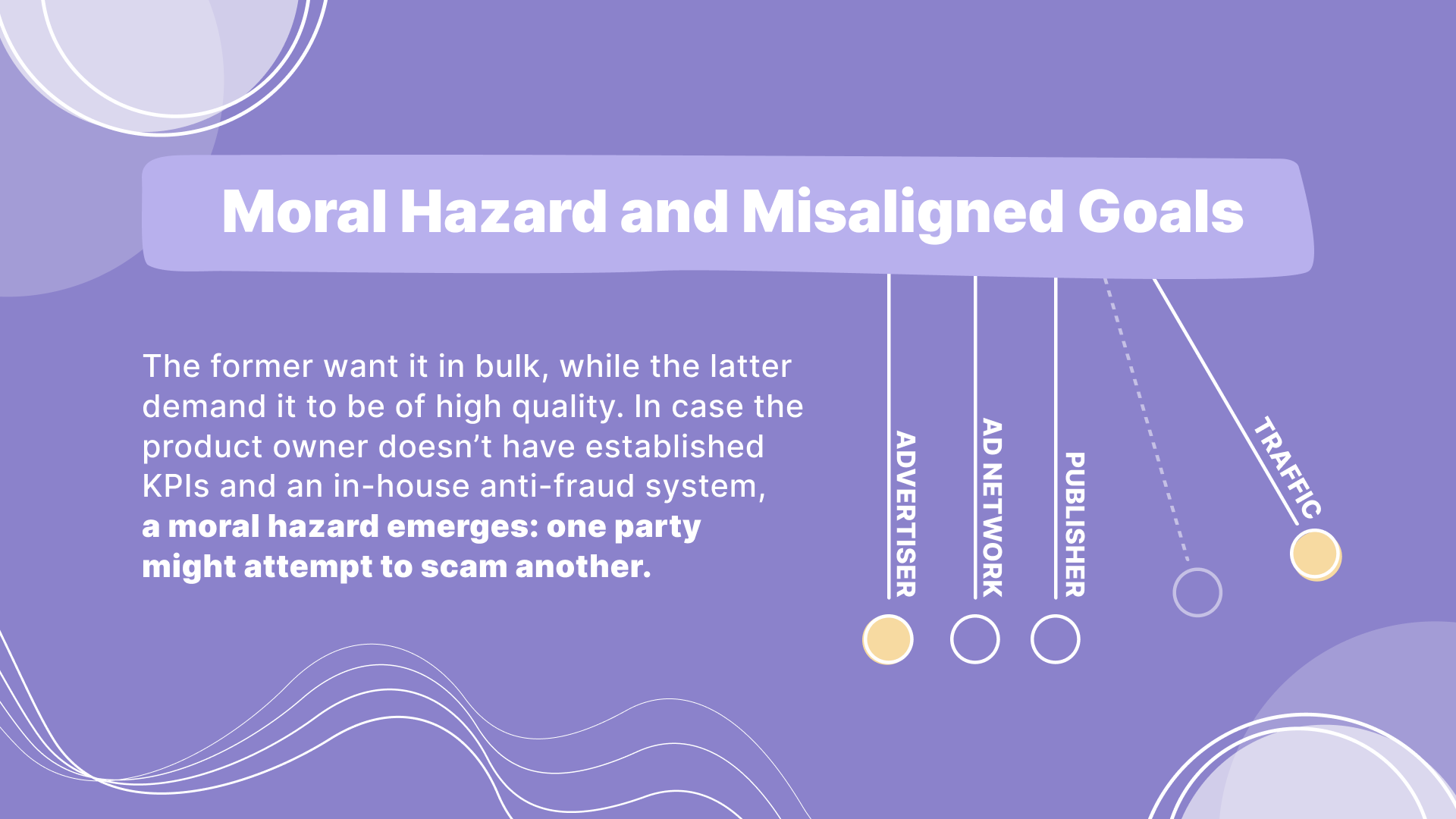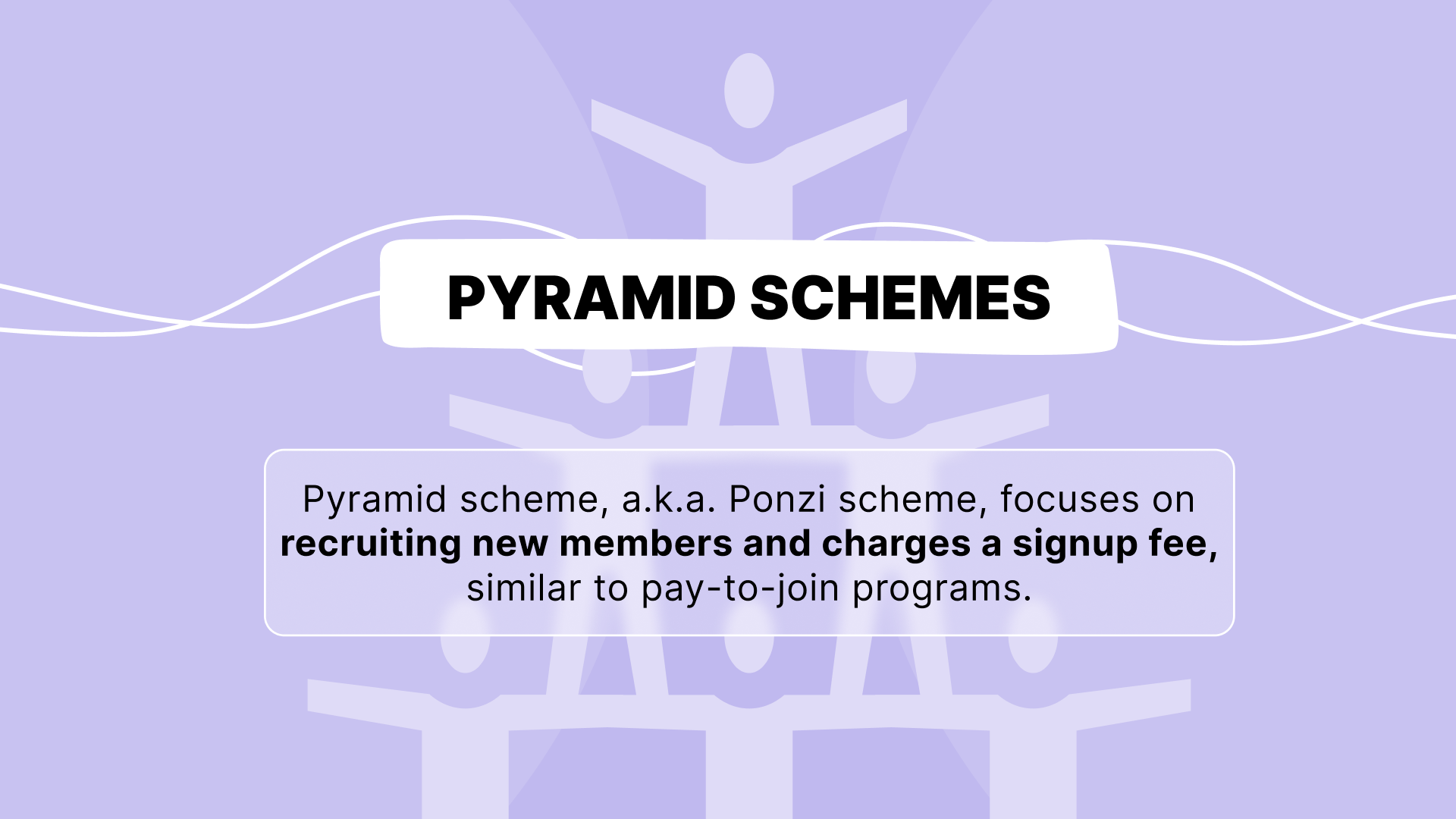You Need to Know How to Detect Affiliate Marketing Scams

Scams are a problem in the affiliate marketing industry. Webmasters, affiliates, merchants — they all can scam and get scammed, due to misaligned marketing goals.
In this article, we’ll explain how the incentive to deceive emerges. Then, we’ll go through the most common affiliate marketing scams and how you can counter them. Finally, we’ll sum everything up and provide a checklist of how not to get fooled.
Moral Hazard and Misaligned Goals

Affiliate marketing is a business, and like any enterprise, it suffers from classic problems of economics, one of which is the principal-agent problem. In a nutshell, it is a conflict of values and priorities between the employer (principal) and the employee (agent).
To understand this misalignment, let’s go through the assets every affiliate marketing party has and define what they want:
- Publishers have an audience, which they want to monetize
- Affiliates have marketing knowledge and want their advertising revenue to outweigh the cost
- Merchants have a product, which they want to sell
To sell and to make a profit — that’s the ultimate goal of any business. This goal can be achieved directly or indirectly via brand awareness, registrations, installs, and other target actions.
Publishers try to balance monetization and user experience (UX), so they won’t tolerate ad bombardment from marketers and ad networks.
Affiliates look for any ways to boost their conversion rate, so that their commissions grow.
Merchants want to actually sell the product, so they need traffic of quality.
Affiliates and merchants have a conflict of interests in terms of traffic: the former want it in bulk, while the latter demand it to be of high quality. In case the product owner doesn’t have established KPIs and an in-house anti-fraud system, a moral hazard emerges: one party might attempt to scam another.
Affiliate Marketing Scams

In the example above, we’ve talked about how an affiliate may be tempted to scam a merchant. However, it’s a two-way street, so affiliates can fall victim as well. Since HilltopAds is an ad network, we’ll focus on the threats to our advertisers and how to counter them:
Commission Shaving
Commission shaving occurs when merchants refuse to pay affiliates for the traffic of quality. This can occur even after the test runs are approved. As a rule of thumb, the higher the payout, the bigger the risk of falling into the trap.
Shaving is just a single reason for a performance drop. The Conversion Rate (CR) can decrease due to:
- Technical issues of the CPA-network
- Apps blocking outdated lines of tracking code
- Antiviruses messing up with affiliate ID in the link
- Delays in updating statistics
- Violation of the terms and conditions
That's why double-check if you're indeed being shaved. Rely on the following indicators:
- Sudden approval rate drop after a long successful streak
- The same offer from other affiliate networks works as expected
- Your 3rd party tracker outperforms the one from the CPA network
- Incomplete access to commentaries and/or call center records
The best defense against shaving is prevention. Consider this:
- Read the reviews on forums before partnering with an affiliate network
- Split traffic between CPA programs to test them out
- Be wary of double redirects, as wrong GEO is a violation of the offer's conditions
- Use your tracker, so you can easily discover that something is missing
- Complete a testing order to see if the conversion fires (ask your friend or relative)
Cookie Stuffing

Cookie stuffing is a blackhat practice of setting third-party cookies on users’ browsers to steal affiliate commissions. A publisher can accidentally install a piece of malicious code when working with questionable advertisers.
That’s why we encourage both publishers and advertisers to sign up for HilltopAds and work with a network of trustworthy partners, curated by vigilant moderation.
High-ticket offers can take days, weeks, or even months to close the lead — plenty of time to infuse a cookie-stuffing script. Once it’s there, all the creatives begin to work against the honest affiliate, contributing to the income of the fraudster.
Cookie stuffing makes it look as if the dishonest affiliate does all the work, which is why the merchant might be inclined to offer them special terms and increased caps. That’s why in 2018 cookie stuffing accounted for nearly 60% of all affiliate frauds.
Infected websites stuff the cookies into users’ browsers. A simple check is to clean the cookies off your browser and visit the website in question. Pay close attention to the cookies dropped on you: if you see any click cookies without clicking anything — the website is infested. Just make sure the cookies in question are for the clicks and not impressions.
Unless you have the technical background and understand the source code, it’s best to leave website moderation to HilltopAds and profit without worries. And even if you are tech-savvy, two heads are still better than one. Remember, not even eBay was able to detect its top affiliates doing cookie stuffing, until paying out $35 million in commissions.
Pay-to-Join Programs
Legitimate affiliate programs are open by default. You don’t have to pay for the right to make a profit. Scammers may promise super lucrative terms or access to special programs in return for paying a fee.
Make sure to read the terms and conditions attentively. Monthly fees, minimum sales quota, and other suspicious payments are reasons to walk away. The upfront fee to join the network is another cause for worrying, since such payments are rarely a one-time purchase. Usually, it’s a downward spiral, causing the victim to flush down more and more funds.
Next, the information about the product, commission, and extra resources must be communicated clearly — it’s in the best interest of the legitimate network.
Look for free affiliate networks — the default mode in the industry. Remember, no pain, no gain: affiliate marketing requires dedication and commitment but pays out once you learn the ropes. While spending money to make more money works in some cases, a pay-to-join program is not one of them.
Learning the ropes involves ad networks too! With HilltopAds, you won’t have to worry about where to find good traffic sources: Videos, Pushes, Pops, Direct Links, Banners — we work with the most popular ad formats.
Click Stealing
Click stealing, a.k.a. Pay-Per-Click (PPC) fraud, is the artificial and deliberate inflation of traffic statistics. It’s when an actual person or bot pretends to be a legitimate prospect and engages with an ad out of malicious or vindictive interest. While increased stats might seem like a good thing at first glance, all the parties involved suffer in the long run:
- Ad network loses its reputation, since generated traffic doesn’t convert.
- Dashboard stats mislead, encouraging to put more effort into improving pre-landers and every part of the funnel after the click.
- Affiliate wastes their advertising budget on non-converting users.
- Publishers are in danger of losing income, because partners might believe that their site generates junk traffic and give up on further partnership.
To keep click fraudsters at bay, you need a tracker. Check the history of IP addresses in the logs to make sure the same suspicious address doesn’t pop up over and over.
Additionally, monitor your daily traffic activity to detect sudden surges — an omen of fake clicks. Don’t forget to add frequency caps to make sure one ad is not served to the same person all the time.
Finally, gradually fine-tune your campaign to exclude suspicious IPs or inadequate sources and optimize your ad running time — 24/7 might be OK for starting, but you don’t want to attract bots and suspicious nocturnal wanderers.
Pyramid Schemes

Pyramid scheme, a.k.a. Ponzi scheme, focuses on recruiting new members and charges a signup fee, similar to pay-to-join programs. There is a popular myth that affiliate marketing is a Ponzi scheme, which is not the case: the former focuses on sales, unlike the latter.
However, some affiliate marketing programs or courses might be a pyramid scheme or Multi-Level Marketing (MLM) in disguise. If you’re interested in learning more about the working courses, read our dedicated article.

Signs of a Ponzi scheme include vague descriptions, recruitment-focused business models, and fishy reviews. Make sure to read the forums before opting for anything. Check the company’s legal history for any investigations. Finally, don’t pay anything upfront, in case of affiliate programs.
Poor Affiliate Marketing Courses
Affiliate Marketing can return more than $50,000 annually and many people want to join it. As a consequence, scammers pretend to be experts and promote their fake courses, luring in unsuspecting enthusiasts. Refer to our dedicated article for tried-and-true courses.
Fake gurus and their false courses can be recognized by these signs:
- No money-back guarantee. Legitimate businesses are sure of their products, so they are not afraid of returning payments if some people are not satisfied. Scammers know what they are doing and refunding isn’t an option.
- Unrealistic promises. “There ain’t nothing in this world for free” — Cage the Elephant. Fake gurus sway in people by promising a couple of hundred bucks per day. Moreover, they’re so kind to offer a recipe for quick riches that it looks just too good to be true.
- Proofs. A huge red flag is when social proof is nowhere to be found. A not-so-big red flag is when reviews on the front page use very basic words, always give 10 out of 10, and create a feeling as if a single person writes them all. Ask an author of a course for contacts of their successful graduates.
Be mindful of up-sells, as they lead to the sunk-cost fallacy. Scammers might ask for only $7 for a course. Once the transaction is complete, the information there turns out to be obvious and can be found online easily. The next move of the fraudster is to up-sell something with a higher price tag. It can go up to $1,500–2,000 without any actual added value in return.
Typosquatting
Typosquatting, also known as URL hijacking, happens when someone buys a domain name very similar to the real one. If users mistakenly click on this link, they're sent to the real website.
That’s not only the problem of merchants, but successful affiliates too. A marketer could have created a converting pre-lander. A fraudster can copy it and use it to confuse the visitors and claim unearned commissions. For example, the URLs might be:
- “www.cool-lander.com” (original)
- “www.cool-lender.com” (imposter)
That’s a huge problem for organic traffic generation, but other sources can suffer as well. Pay more attention as to where you go and report such websites for copyright violations. You can also go to the Internet Archive to check the history of the domain in question.
Fake and Shady Products
Fake products promise an unachievable result. For example, they might claim to heal herpes or AIDS.
Alternatively, there might be illegal items, which are not so obvious. For instance, StealthGenie or FlexiSPY violate a user’s privacy by reporting all their activity to a jealous spouse, including phone calls, message history, GEO location, etc.
Fake and shady products should not be confused with non-mainstream offers. The former deceive users by promising impossible or violate the law; the latter are perfectly legal, but Facebook and Google moderation don’t like such offers.
Ignorance is your worst enemy here, so make sure to research the offer: look for reviews, warranted statements, and overall clarity. Remember, if you feel something is rotten when reading, it’s better to trust your gut and take a breath of fresh air elsewhere.
Summary
Affiliate marketing scams emerge due to conflicting goals among webmasters, affiliates, and merchants. These scams include commission shaving, cookie stuffing, pay-to-join programs, click stealing, pyramid schemes, typosquatting, and fake/shady products. To combat these scams, it's crucial to:
- Be vigilant for signs of scams, such as sudden drops in commission rates or unrealistic promises
- Utilize prevention strategies like reading reviews, splitting traffic between programs, and using trackers
- Stay informed about industry practices and be cautious of pay-to-join programs or courses promising quick riches
- Report fraudulent activities and protect your online presence from typosquatting or fake product promotions
- Research offers thoroughly and trust your instincts when something seems too good to be true
By being aware of these scams and implementing preventive measures, individuals can safeguard themselves from falling victim to affiliate marketing fraud.
You also need a trustworthy partner like HilltopAds with an in-house anti-fraud system. With our help, you can generate large volumes of traffic, marked by its quality, to please even the pickiest merchants. With us, you can achieve long-term and sustainable profit.

